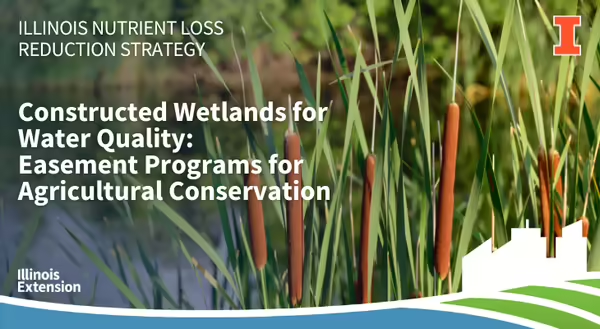
Both restored and constructed wetlands can play a big role in reducing nutrient loss. In episode 71 of the Illinois Nutrient Loss Reduction Podcast, Paula Hingson and Matt Robert of USDA NRCS explained how programs like wetland restoration easement through the Agricultural Conservation Easement Program (ACEP) support landowners by converting flood-prone farmland back to wetlands, and how constructed wetlands are engineered to treat runoff and improve water quality. The conversation also covers funding options, habitat benefits, and how producers can get started with support from local NRCS offices and partners like The Wetlands Initiative.
What is an easement?
Easements can be many things, including a utility right away or an encumbrance on a piece of property where a third party has purchased the rights to the property. The federal government is purchasing the easement rights for the easement wetland restoration program. The wetland restoration program gives the government the right to construct the wetland and restore the area to what it had historically been. Another easement program allows the land to stay in agricultural production but prohibits further development. Current easement programs focus on wetland restoration, not constructed wetlands.
Restored vs constructed wetlands
According to Paula Hingson, restored wetlands bring back natural wetland areas, typically in fields with low spots that flood often or have hydric soils. Through the ACEP, landowners can place these acres under a 30-year or permanent easement, while NRCS covers the restoration cost. In Illinois, restored wetlands tend to be larger than constructed wetlands because they often handle a larger volume of water. They are in place to slow water down, trap sediment, take up nutrients, and offer wildlife habitat for migratory birds and recreational opportunities such as hunting.
Matt Robert explains that constructed wetlands are engineered systems that are designed specifically to treat tile or surface runoff and to remove nutrients like nitrogen and phosphorus. These wetlands are typically installed at pinch points, where you could possibly have a culvert or grass waterway, where you could place the constructed wetland and size it properly with the right vegetation. These can be funded through NRCS programs like EQUIP.
Both types of wetlands act as a natural water filter. They can absorb and retain large quantities of water, slowly letting it out over time instead of diverting it quickly, like through a drainage way or culvert.
Why install a wetland?
Paula noted that wet areas that flood often and tend to lose crops can be a great fit for a wetland to take that land out of crop production. Paula explained that they would still own the land and, with funding, could turn unproductive land into systems that reduce nutrient runoff and improve habitat. Furthermore, they would get paid for the easement and would not have to keep worrying about yield loss.
To listen to the full interview with Paula Hingson and Matt Roberts, check out the Illinois Nutrient Loss Reduction Podcast episode 71. For more information about the wetland easement program or EQIP, visit your local NRCS office.
About the authors
Rachel Curry is an Agriculture and Agribusiness Educator specializing in agriculture and watershed education, and she is part of the Illinois Extension's Nutrient Loss Reduction Strategy implementation team. She holds a B.A. in Environmental Studies from Knox College and an M.S. in Environmental Science and Soil Science from Iowa State University, focusing on soil fertility. Her work centers on education and outreach related to the Illinois Nutrient Loss Reduction Strategy, promoting agricultural conservation practices that reduce nutrient loss while enhancing water quality and soil health across Illinois.
Nicole Haverback serves as a Watershed Outreach Associate and is an Illinois Extension team member implementing the Nutrient Loss Reduction Strategy. She holds a B.S. in Agricultural and Rural Policy Studies from Iowa State University. In her role, Nicole coordinates watershed management and planning efforts aimed at reducing nutrient losses in priority areas, offers expertise on best management practices to minimize nutrient loss, and leads outreach initiatives promoting agricultural conservation practices outlined in the Illinois Nutrient Loss Reduction Strategy.
About the blog
At Illinois Extension, we’re working to improve water quality at home and downstream. Every month, our Watershed Outreach Associates will bring you stories highlighting agricultural conservation practices, current research projects and results, and from the field farmer interviews. The Nutrient Loss Reduction blog covers conservation practices recommended by the Illinois Nutrient Loss Reduction Strategy, timely updates, farm safety, and new decision tools to help farmers and producers reduce the nutrients leaving their field.